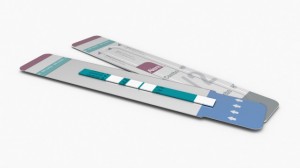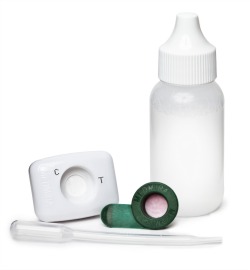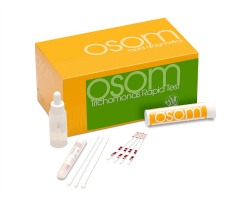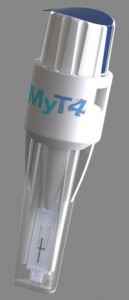This is a sidebar to CLP’s June feature, “STD/HIV Testing.”
Today’s STD and HIV testing devices strive to get results quickly and easily, in a variety of clinical settings. Some offer advances never seen before. Here’s a look at some current offerings.
Alere’s Determine HIV-1/2 Ag/Ab Combo
Alere Inc, Orlando, Fla, manufactures the Alere Determine HIV-1/2 Ag/Ab Combo, which tests for HIV-1 and 2. This point-of-care test provides rapid results in 20 minutes, and detects both HIV 1/2 antibody and HIV 1 p24 antigen in separate windows. The product is the first fourth-generation point-of-care rapid HIV test, and was cleared by FDA in August 2013. It is also the only rapid HIV test that can report separate results for HIV 1/2 antibody and HIV-1 p24 antigen detection.
It can also identify HIV acutely infected individuals, says Joe Medeiros, Alere’s general manager for North America virology solutions. By detecting the HIV-1 p24 antigen, which can appear just 12 to 26 days after infection, the Alere Determine HIV-1/2 Ag/Ab Combo can detect HIV earlier than conventional second- and third-generation rapid tests. Identifying HIV infection early, during the most infectious stage, helps link patients to effective care and treatment sooner, while also reducing the risk of infecting others, since individuals who are unaware of their infection are more than three times more likely to transmit the virus to someone else.
Bio-Rad’s Droplet Digital PCR
Scientists have been drawn to Bio-Rad’s Droplet Digital polymerase chain reaction (ddPCR) system particularly to solve “needle in a haystack” problems, reports George Karlin-Neumann, PhD, director of scientific affairs at the Bio-Rad digital biology center in Pleasanton, Calif. The HIV community was among the first to rigorously validate ddPCR’s increased sensitivity in detecting the presence of rare HIV pro-viral deoxyribonucleic acid (DNA) integrated into the chromosomes of treated patients’ immune cells.
The ability to measure as low as one viral sequence in approximately one million copies of the human genome has provided an enhanced ability to assess HIV eradication strategies. Using this technology, researchers from the University of California, San Diego, helped to confirm clinicians’ judgment that an infant from Mississippi who had been born infected with HIV and immediately treated with aggressive anti-retroviral therapy was later functionally cured.1 More recently, it was used to evaluate a 9-month-old infant undergoing treatment. “The encouraging results from these early cases has led to a clinical trial to test the hypothesis that perinatal treatment of HIV-infected infants can prevent persistent infection and may lead to treatment strategies that are no longer for a lifetime,” Karlin-Neumann says.
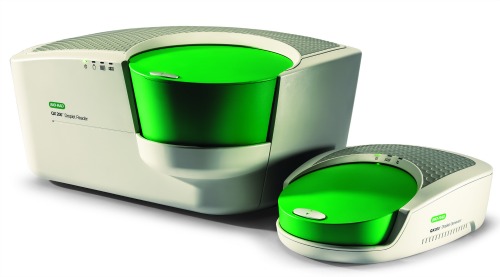
Bio-Rad Laboratories’ second-generation droplet digital PCR system, the QX200, provides absolute quantification of target DNA or RNA molecules using EvaGreen or TaqMan hydrolysis probes for high sensitivity and precision for various applications.
Another important use of ddPCR is in guiding gene editing-based therapies. In efforts to restore an HIV patient’s immune system, researchers disrupted the CCR5 gene required for virus cell entry in immune cells taken from HIV patients to block future viral infection of these cells. They then used ddPCR to monitor the levels of the reintroduced T-cells in the blood over many months to assess success of the treatment.
Based on a simple concept, Bio-Rad’s QX100 and QX200 ddPCR systems provide a means of subdividing a biological sample into many small droplets and counting which ones have the DNA (or ribonucleic acid [RNA]) molecule of interest and which do not. “From this, you can get exquisitely sensitive and precise quantitation of important biological markers, guiding us in making critical clinical measurements,” Karlin-Neumann says.
While ddPCR is still in the early translational stages of being used to assess HIV patient status and to monitor patients undergoing cutting-edge therapies, it continues to be critically evaluated in HIV labs focused on developing eradication strategies.
Bio-Rad’s digital biology center is ISO 13485 certified and will seek CE marking and FDA approval for its assays.
Luminex Corp’s MultiCode-RTx HSV 1&2 Kit
The MultiCode-RTx HSV 1 and 2 kit tests for herpes simplex virus 1 and 2. Its benefits include IVD cleared; high sensitivity and specificity; same-day results for rapid turnaround time; and a streamlined workflow which simplifies implementation for both large and small laboratories, says Erin McCombs, senior marketing manager for Luminex Corp, Austin, Tex. A sample processing control for monitoring extraction and amplification as well as analysis software for automatic analysis and result reporting are included. MultiCode-RTx is a probe-free, real-time PCR technology that can simultaneously detect and type HSV 1 and 2. Confirmatory melt curves provide added confidence in results.
MedMira’s Reveal G3 Rapid HIV-1 antibody test
MedMira offers the Reveal G3 Rapid HIV-1 antibody test, a point-of-care test for use with plasma or serum in the United States. “In emergency situations, time means everything,” says Kevin Jones, senior director of sales and marketing for MedMira, Halifax, Nova Scotia, Canada. “A fast, simple, and economical rapid test that delivers results instantly can provide healthcare providers and their patients with critical information required to take immediate action and select the right follow-up and treatment plan.”
The test is equipped with a built-in procedural and reagent control line that enables the user to know the test is operating correctly every time. “This provides added confidence when the tests are used at the point of care and the user does not have the ability to run external controls every time,” Jones says.
Additionally, because precision pipetting, sample manipulation, specialized equipment, and training are not required to perform any of MedMira’s rapid tests, they can be used in most any point-of-care setting, including in a counseling or instant result situation such as the emergency department or other emergency/disaster response situations. Moreover, Reveal G3 allows the results from a serum or plasma specimen to be read within 2 minutes of applying the sample. Its sensitivity is 99.8% while its specificity is 99.7%.
The simple test procedure involves adding the specimen to the device and allowing the reagents to be applied from the top and flow vertically through a matrix. “Gravity works to accelerate the test, allowing results to be generated instantly as opposed to 20 minutes or more for other HIV tests,” Jones explains. The MedMira assay is comprised of a one-step cartridge that delivers the decreased time.
Roche’s Cobas HPV test
Roche’s Cobas HPV DNA-based test detects 14 high-risk types of human papillomavirus (HPV) and reports individual genotype results for HPV 16 and HPV 18, the two highest-risk types, along with a pooled result for the other 12 high-risk types. It is the first non-Pap test to be FDA approved for use as a first-line primary screening test for cervical cancer with women aged 25 and older, and it may also be used as a reflex test for inconclusive (ASC-US) Pap results (for women age 21 and older) and as a co-test along with Pap (for women age 30 and older), says Chris Norris, director of marketing for molecular diagnostics at Roche Diagnostics, Indianapolis.
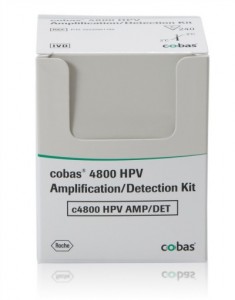
The Cobas HPV test from Roche is the first test approved in the United States that can be used instead of Pap in first-line primary screening for cervical cancer in women aged 25 and older.
Clinically validated by the landmark ATHENA trial,2 the Cobas HPV test is the only FDA-approved HPV assay that provides both a pooled high-risk result and specific genotyping information for HPV 16 and 18 in one test. This can all be done in one run, from one patient sample.
The test is performed on the Cobas 4800 system, which offers walk-away automation of nucleic acid purification, PCR set-up and real-time PCR amplification, and detection to help laboratories achieve maximum efficiency. The system also runs the Cobas CT/NG test (Chlamydia/gonorrhea), the Cobas BRAF V600 mutation test, and the Cobas EGFR mutation test.
Sekisui Diagnostics’ OSOM Trichomonas rapid test
The OSOM trichomonas rapid test by Lexington, Mass-based Sekisui Diagnostics is the only CLIA-waived, rapid diagnostic test available for detection of Trichomonas vaginalis. As an antigen test, it can detect the presence of the organism whether alive or dead. “Labs do not have to worry about the viability of the organism before they get the sample to the microscope,” says Stephanie Wells, senior director for global marketing. “This allows labs to take on testing from alternate sites without sacrificing accuracy. It gives them the freedom to run the test for a stat result or to wait and perform batch testing at a later time.” The OSOM test has a sensitivity of 83%.
The 10-minute rapid test allows labs to test, provide a result to the emergency department, and have the physician treat and educate the patient before they leave.
Ultimately, the test can reduce labor costs and physician microscopy time, which will allow them to see more patients. Additionally, the decreased hands-on time of performing the OSOM test significantly decreases the amount of time that medical technologists must devote to microscopy.
Siemens’ Advia Centaur HIV Ag/Ab Combo assay
While not available quite yet, Siemens Healthcare recently submitted a premarket approval application for its Advia Centaur HIV Ag/Ab Combo assay to the FDA for review. The assay is designed to simultaneously detect the presence of HIV p24 antigen (produced by the HIV virus) and antibodies, which could allow for earlier detection of HIV infection than antibody tests. The assay, intended to be used as an aid in the diagnosis of HIV-1/HIV-2 infection, including acute or primary HIV-1 infection, has been available for use in Europe since 2010.
Zyomyx’s MyT4 CD4 test
Zyomyx’s MyT4 CD4 test, which is CE marked, is designed to guide HIV/AIDS treatment initiation and monitoring. It can be used in labs and in remote settings for true point-of-care testing. The configuration described here is designed for use in Africa. Among its attributes is the ability to provide an accurate quantitative CD4 result in 10 minutes. It’s also service-free. “It does not require any maintenance, calibration, or swap to a central location for repairs, because all complex technology is contained in the disposable test, not in an instrument,” explains Shira Lee, MS, lead product manager at Zyomyx, Fremont, Calif. “This is significant for Africa, where this configuration is currently commercialized.”
The test uses capillary or venous whole blood. All of the reagents are contained in the test, and there are automatic internal quality controls. Therefore, minimal steps are involved with running a test, and minimal training is required. The instrument to run the test is very affordable ($500 to $900) compared to alternatives. The cost per test is projected to be $6 to $12 in Africa. “The cost to adopt the test is minimal compared to thousands of dollars for instrument-based platforms,” Lee says.
In addition, the MyT4 CD4 test has the highest throughput of any point-of-care CD4 test on the market. “The test delivers results at the point of care that are equivalent to lab-based flow cytometry, the gold standard of CD4 testing,” Lee says. The associated accessory is powered by a rechargeable battery that holds 50 tests per charge, more than any existing CD4 test in Africa. It is designed to remain robust in fluctuating electricity conditions.
References
1. Persaud D, Gay H, Ziemniak C, et al. Functional HIV cure after very early ART of an infected infant. Presentation to the 20th Conference on Retroviruses and Opportunitic Infections (Atlanta; 3-6 March 2013): Abstract 48LB.
2. Stoler MH, Wright TC, Sharma A, et al. High-risk human papillomavirus testing in women with ASC-US cytology: Results from the ATHENA HPV study. Am J Clin Pathol. 2011;135(3): 468-475.


